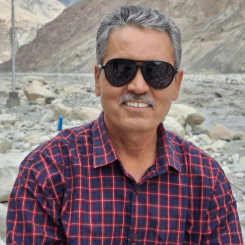
History says, Maharshi Debendranath Tagore on 1861, father of Gurudev Rabindranath Tagore established “Santiniketan Ashram” as a meditation retreat and a place for worshiping and confluence of all religion cultures. In 1901, Gurudev initiated his educational experiment by establishing “Brahma Vidyalaya” which was later transformed as “Patha Bhavana Ashram Vidyalaya”. He was deeply influenced by the ancient, traditional and classical Bharatiya (Indian) “Tapabana” educational system. In his experimental school (Vidyalaya) he started education with regular practice of sangeet (music), nrittya (dance), natak (drama), kalas (arts), Vyayama (exercise), Krida (sport) and Yoga. He received “Nobel Prize” in the year of 1913 and his experiment on education was propounded and acknowledged all over the world. Gurudev established Visva-Bharati (1921) a global University (Visva Vidyalaya) with the essence of best of the east and west. On 1924, Siksha Satra a school for village and tribal people to train them vocational skills was established by Tagore in his new experiment. The idea of Bharatiya style of teacher training and for the expansion of his educational ethos and culture for future generation Gurudev established Siksha Charcha in 1937.
The glorious history of Vinaya Bhavana started before our independence, from 26 December, 1946, when the foundation stone was laid by Sri Chakravarti Rajagopalachari, member of Education, Govt. of India. A green land in the middle of Santiniketan and Sriniketan was chosen for reviving ‘Bharatiya Guru Sishya Parampara’ (Indian teacher student tradition) for the purpose to build the backbone of education in India. The name ‘Vinaya’ and its noteworthiness were elucidated by Pandit Kshiti Mohan Sen, an eminent Indologist scholar, which in Buddhist scriptures meant ‘discipline’ and ‘education’. At this ceremony the then Upacharya Smt. Sarojini Devi addressed the gathering regarding the need of basic education in Bharata. The Education Secretary Sri D.M. Sen explained the need of best teachers to create a future of Bharata on ideals of Gurudev’s philosophy and vision. Vinaya Bhavana following the objective which was collected from the sacred text of Srimad Bhagabad Gita and depicted in the front gate
"तद्विद्धि प्रणिपातेन परिप्रश्नेन सेवया ।
उपदेक्ष्यन्ति ते ज्ञानं ज्ञानिनस्तत्त्वदर्शिन:"
Learn the truth by approaching a spiritual master.
Inquire from him with reverence and render service unto him.
Such an enlightened saint can impart knowledge unto you because he has seen the Truth”.
(Chapter 4, Verse-34)
Sri Rathindra Nath Tagore, son of Gurudev Rabindranath tagore, the then Registrar of Visva-Bharati, took keen interest and with his dedicated and determined teamwork finally prepared the Vinaya Bhavana Campus. It started teachers training courses on 1948 and subsequently developed as a full- fledged teachers training college in 1951 under Visva-Bharati, a Central University with National Importance, Govt. of India. Tagore’s holistic and integrated system of education where nature, culture, heritage and future development are merging together. Presently Vinaya Bhavana is following the traditional Bharatiya educational system and following NCTE, UGC-NEP-2020, Ministry of Education and Vikshit Bharat, Govt. of India guidelines. In future Vinaya Bhavana wishes to start new courses in the following areas: Indian Knowledge System, Inclusive Education and Application of Artificial Intelligence (AI) in Education etc.
There are three constituent department in Vinaya Bhavana, i) Department of Education ii) Department of Physical Education & Sport Science iii) Department of Yogic Art and Science and offering Diploma, UG, PG and PhD programme. Vinaya Bhavana believes and practices human with nature and human to human integration. Inside the Vinaya Bhavana campus one may feel a spiritual vibration which will occupy when enter into this beautiful serene environment.
Principal
Vinaya Bhavana
(Institute of Education)
Visva-Bharati, Santiniketan
West Bengal, India